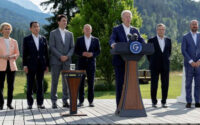The United States is experiencing a blistering heat wave that’s putting major strain on the country’s electrical grids. As temperatures soar in the Western U.S., air conditioning units are working overtime, drawing far more energy from the grid than usual. This is a serious concern, as the nation’s power grids are antiquated and often underperforming on the best of days. And in heat above 100 degrees, a blackout could be extremely dangerous, if not deadly.
In Las Vegas, Nevada, temperatures have hovered around 110 degrees for over a week. Same story in Phoenix, Arizona, where the metro area smashed its previous record for electricity consumption. California’s Death Valley is also seeing temperatures above 110, but that’s after the sun goes down. In fact, the region is inching closer and closer to its previous record for high temperatures – the highest ever recorded on Earth – at 134F (56.7C). Just this Sunday, the mercury hit 128F (53.3C) at the appropriately named Furnace Creek.
In the midst of these sweltering conditions in California, officials are beseeching residents not to turn their thermostats below 78 degrees Fahrenheit to prevent potential blackouts. “When you’ve got really hot temperatures that don’t cool down at night, that can be really taxing on the electrical equipment,” Jeff Smith, a representative from Pacific Gas and Electric, was quoted by CBS News this week. In particular, the risk of transformer failures increases significantly in such conditions.
In Texas, the grid has so far held up, but that was far from a sure thing. Texas’ grid has failed to endure extreme weather events in the past, with tragic consequences. In February of 2021, the Texas grid collapsed under the strain of increased energy demand to heat homes during the disastrous Winter Storm Uri. Tragically, 246 people (at least) died as a result of the storm and the resulting grid failure. That’s the official number, but a BuzzFeed News analysis says that the real death toll is likely to be closer to 700 lives lost.
The tragedy was not just a result of the severity of the storm, but also the uniquely deregulated and isolated nature of Texas’ electric grid. Texas found itself in serious trouble when it ran out of energy to supply its own grid and wasn’t able to import electricity from interconnected grids in other states. Texas has been cutting its ties with the national grid for years in order to avoid federal regulation and the objectively flawed traditional U.S. utility model, which also led to a lack of adequate weatherization and failsafe mechanisms. So far this year, however, the Texas grid has held strong through record energy demand, in large part thanks to huge increases in battery installation as well as available solar power production capacity to meet demand and give more flexibility to the grid.
While things are looking up in Texas, however, the current strain on the grid throughout the west speaks to a major infrastructural issue at a national level. “Most of the world’s transmission infrastructure was built between 40 and as much as 80 years ago, and much of it is operating well past age and design limits,” former Federal Energy Regulatory Commission (FERC) commissioner and PG&E chair Nora Mead Brownell told Electrek earlier this year. “Utilities currently don’t monitor their power lines for conditions that affect carrying capacity; like how much a line is sagging or swaying or ambient temperatures. In fact, 99% of power lines aren’t monitored at all, and that’s a problem,” she continued.
The old and inadequate infrastructure, along with the monitoring issues, could lead to huge and life-threatening issues in places experiencing extreme weather events. As climate change advances, such extreme weather patterns are expected to become both more frequent and more intense. But speaking of climate change, switching the grid over to renewable energy on a dime isn’t a great option either. Our grid is woefully unprepared for the green energy transition, which will require huge additions in transmission infrastructure and grid flexibility to account for increasing electrification and an influx of variable energy.
To address these huge looming issues, the Biden administration has introduced the Building a Better Grid Initiative and, through the Bipartisan Infrastructure Law, has earmarked $13 billion to modernize and expand the nation’s power grid. While this is a great start, however, it’s nowhere near ambitious enough to solve the problem. The International Energy Agency estimates that annual investments in energy sector infrastructure and technologies will need to increase four-fold from current levels to reach $4 trillion by 2030 in order to achieve net-zero emissions by 2050.
By Haley Zaremba for Oilprice.com
More Top Reads From Oilprice.com:


